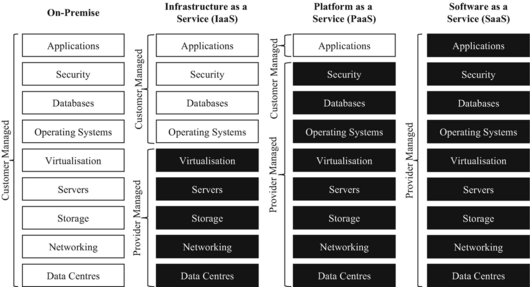User:Buidhe paid/Software

Software is defined narrowly as unambiguous instructions that can be transformed into a form executable on computer hardware, or more broadly including supporting concepts, tools and methods needed to make the computer system operational.
Building off of previous innovations in
Definition
Software can be defined more narrowly as the instructions executed by the
History

A host of earlier inventions were necessary for the creation of software, including
The first programmable computers, which appeared at the end of the 1940s,
The first software was tied closely to the underlying hardware and consequently was not
Types

There are two main types of software:
- Operating systems are "the layer of software that manages a computer's resources for its users and their applications".[20] There are three main purposes that an operating system fulfills:[21]
- Allocating resources between different applications, deciding when they will receive central processing unit (CPU) time or space in memory.[21]
- Providing an interface that abstracts the details of accessing hardware details (like physical memory) to make things easier for programmers.[21][22]
- Offering common services, such as an interface for accessing network and disk devices. This enables an application to be run on different hardware without needing to be rewritten.[23]
- Application software runs on top of the operating system and uses the computer's resources to perform a task.[24] There are many different types of application software because the range of tasks that can be performed with modern computers is so large.[25] Applications account for most software[26] and require the environment provided by an operating system, and often other applications, in order to function.[27]

Software can also be categorized by how it is
Software development and maintenance
Software companies aim to deliver a high-quality product on time and under budget. A challenge is that
Frequently, software is
Completing a software project involves various forms of expertise, not just in
Quality and security
Software quality is defined as meeting the stated requirements as well as customer expectations.[50] Quality is an overarching term that can refer to a code's correct and efficient behavior, its reusability and portability, or the ease of modification.[51] It is usually more cost-effective to build quality into the product from the beginning rather than try to add it later in the development process.[52] Higher quality code will reduce lifetime cost to both suppliers and customers as it is more reliable and easier to maintain.[53][54] Software failures in safety-critical systems can be very serious including death.[53] By some estimates, the cost of poor quality software can be as high as 20 to 40 percent of sales.[55] Despite developers' goal of delivering a product that works entirely as intended, virtually all software contains bugs.[56]
The rise of the Internet also greatly increased the need for
Encoding and execution
Programming languages
Programming languages are the format in which software is written. Since the 1950s, thousands of different programming languages have been invented; some have been in use for decades, while others have fallen into disuse.
Compilation, interpretation, and execution
The invention of high-level programming languages was simultaneous with the
Legal issues
Liability
Software is often released with the knowledge that it is incomplete or contains bugs. Purchasers knowingly buy it in this state, which has led to a legal regime where liability for software products is significantly curtailed compared to other products.[72]
Licenses

Source code is protected by
Patents
Impact

Engineer
References
- ^ a b c Kitchin & Dodge 2011, p. 5.
- ^ Osterweil 2013, p. 61.
- ^ a b c d Tracy 2021, p. 2.
- ^ Kitchin & Dodge 2011, pp. 3, 24.
- ^ a b Tracy 2021, p. 3.
- ^ Kitchin & Dodge 2011, p. 24.
- ^ Kitchin & Dodge 2011, pp. 3–4.
- ^ Jones 2014, pp. 19, 22.
- ^ Jones 2014, pp. 9, 21.
- ^ a b Jones 2014, p. 19.
- ^ Jones 2014, p. 22.
- ^ Gabbrielli & Martini 2023, p. 519.
- ^ Gabbrielli & Martini 2023, pp. 520–521.
- ^ Gabbrielli & Martini 2023, p. 522.
- ^ Gabbrielli & Martini 2023, p. 521.
- ^ a b Tracy 2021, p. 1.
- ^ Tracy 2021, p. 249.
- ^ Tracy 2021, p. 250.
- ^ Tracy 2021, pp. 250–251.
- ^ Anderson & Dahlin 2014, p. 6.
- ^ a b c Anderson & Dahlin 2014, p. 7.
- ^ Tanenbaum & Bos 2023, p. 5.
- ^ Anderson & Dahlin 2014, pp. 7, 9, 13.
- ^ Anderson & Dahlin 2014, pp. 6–7.
- ^ Jones 2014, p. 121.
- ^ Tracy 2021, p. 66.
- ^ Tracy 2021, p. 72.
- ^ a b O'Regan 2022, p. 386.
- ^ Campbell-Kelly & Garcia-Swartz 2015, pp. 156–157.
- ^ Rosati & Lynn 2020, p. 23.
- ^ Watt 2023, p. 4.
- ^ O'Regan 2022, p. 7.
- ^ O'Regan 2022, p. 5.
- ^ a b Dooley 2017, p. 1.
- ^ O'Regan 2022, pp. 18, 110–111.
- ^ Tracy 2021, pp. 43, 76.
- ^ O'Regan 2022, pp. 117–118.
- ^ O'Regan 2022, p. 54.
- ^ O'Regan 2022, p. 267.
- ^ O'Regan 2022, p. 20.
- ^ O'Regan 2022, p. 9.
- ^ Tripathy & Naik 2014, p. 26.
- ^ Reifer 2012, p. 22.
- ^ Tripathy & Naik 2014, pp. 4, 27.
- ^ Tripathy & Naik 2014, p. 89.
- ^ Varga 2018, p. 6.
- ^ Ulziit et al. 2015, p. 764.
- ^ Tucker, Morelli & de Silva 2011, p. 7.
- ^ Stull 2018, pp. 24–25.
- ^ Galin 2018, p. 3.
- ^ Galin 2018, p. 26.
- ^ O'Regan 2022, pp. 68, 117.
- ^ a b O'Regan 2022, pp. 3, 268.
- ^ Varga 2018, p. 12.
- ^ O'Regan 2022, p. 119.
- ^ Ablon & Bogart 2017, p. 1.
- ^ Campbell-Kelly & Garcia-Swartz 2015, p. 164.
- ^ a b O'Regan 2022, p. 266.
- ^ a b c Ablon & Bogart 2017, p. 2.
- ^ Daswani & Elbayadi 2021, p. 25.
- ^ Daswani & Elbayadi 2021, pp. 26–27.
- ^ Haber & Hibbert 2018, pp. 5–6.
- ^ Kitchin & Dodge 2011, p. 37.
- ^ Tracy 2021, p. 117.
- ^ Tracy 2021, pp. 118–120.
- ^ Tracy 2021, pp. 118–119.
- ^ Kitchin & Dodge 2011, p. 26.
- ^ Tracy 2021, p. 121.
- ^ Tracy 2021, pp. 122–123.
- ^ O'Regan 2022, p. 375.
- ^ Sebesta 2012, p. 28.
- ^ Kitchin & Dodge 2011, pp. 36–37.
- ^ O'Regan 2022, pp. 394–396.
- ^ a b O'Regan 2022, p. 403.
- ^ O'Regan 2022, pp. 394, 404.
- ^ Langer 2016, pp. 44–45.
- ^ O'Regan 2022, p. 395.
- ^ Gerardo Con Díaz, "The Text in the Machine: American Copyright Law and the Many Natures of Software, 1974–1978", Technology and Culture 57 (October 2016), 753–79.
- ^ O'Regan 2022, p. 398.
- ^ O'Regan 2022, p. 399.
- ^ a b Manovich 2013, p. 333.
- ^ Jones 2014, p. 32.
- ^ Kitchin & Dodge 2011, p. iv.
- ^ a b c Jones 2014, p. xxviii.
- ^ Manovich 2013, p. 329.
Sources
- Ablon, Lillian; Bogart, Andy (2017). Zero Days, Thousands of Nights: The Life and Times of Zero-Day Vulnerabilities and Their Exploits (PDF). Rand Corporation. ISBN 978-0-8330-9761-3.
- ISBN 978-0-9856735-2-9.
- Campbell-Kelly, Martin; Garcia-Swartz, Daniel D. (2015). From Mainframes to Smartphones: A History of the International Computer Industry. Harvard University Press. ISBN 978-0-674-28655-9.
- ISBN 978-1-4842-6654-0.
- Dooley, John F. (2017). Software Development, Design and Coding: With Patterns, Debugging, Unit Testing, and Refactoring. Apress. ISBN 978-1-4842-3153-1.
- Gabbrielli, Maurizio; Martini, Simone (2023). Programming Languages: Principles and Paradigms (2nd ed.). Springer. ISBN 978-3-031-34144-1.
- Galin, Daniel (2018). Software Quality: Concepts and Practice. John Wiley & Sons. ISBN 978-1-119-13449-7.
- Haber, Morey J.; Hibbert, Brad (2018). Asset Attack Vectors: Building Effective Vulnerability Management Strategies to Protect Organizations. Apress. ISBN 978-1-4842-3627-7.
- Jones, Capers (2014). The Technical and Social History of Software Engineering. Pearson Education. ISBN 978-0-321-90342-6.
- Kitchin, Rob; Dodge, Martin (2011). Code/space: Software and Everyday Life. MIT Press. ISBN 978-0-262-04248-2.
- Langer, Arthur M. (2016). Guide to Software Development: Designing and Managing the Life Cycle. Springer. ISBN 978-1-4471-6799-0.
- Manovich, Lev (2013). Software Takes Command. Bloomsbury Academic. ISBN 978-1-62356-745-3.
- O'Regan, Gerard (2022). Concise Guide to Software Engineering: From Fundamentals to Application Methods. Springer Nature. ISBN 978-3-031-07816-3.
- Osterweil, Leon J. (2013). "What Is Software? The Role of Empirical Methods in Answering the Question". Perspectives on the Future of Software Engineering: Essays in Honor of Dieter Rombach. Springer. pp. 237–254. ISBN 978-3-642-37395-4.
- Rahman, Hanif Ur; da Silva, Alberto Rodrigues; Alzayed, Asaad; Raza, Mushtaq (2024). "A Systematic Literature Review on Software Maintenance Offshoring Decisions". Information and Software Technology. 172: 107475. .
- Reifer, Donald J. (2012). Software Maintenance Success Recipes. CRC Press. ISBN 978-1-4398-5167-8.
- Rosati, Pierangelo; Lynn, Theo (2020). "Measuring the Business Value of Infrastructure Migration to the Cloud". Measuring the Business Value of Cloud Computing. Springer International Publishing. pp. 19–37. ISBN 978-3-030-43198-3.
- Sebesta, Robert W. (2012). Concepts of Programming Languages (10 ed.). Addison-Wesley. ISBN 978-0-13-139531-2.
- Stull, Edward (2018). UX Fundamentals for Non-UX Professionals: User Experience Principles for Managers, Writers, Designers, and Developers. Apress. ISBN 978-1-4842-3811-0.
- ISBN 978-1-292-72789-9.
- Tracy, Kim W. (2021). Software: A Technical History. Morgan & Claypool Publishers. ISBN 978-1-4503-8724-8.
- Tripathy, Priyadarshi; Naik, Kshirasagar (2014). Software Evolution and Maintenance: A Practitioner's Approach. John Wiley & Sons. ISBN 978-0-470-60341-3.
- Tucker, Allen; Morelli, Ralph; de Silva, Chamindra (2011). Software Development: An Open Source Approach. CRC Press. ISBN 978-1-4398-8460-7.
- Ulziit, Bayarbuyan; Warraich, Zeeshan Akhtar; Gencel, Cigdem; Petersen, Kai (2015). "A conceptual framework of challenges and solutions for managing global software maintenance". Journal of Software: Evolution and Process. 27 (10): 763–792. doi:10.1002/smr.1720.
- Watt, Andy (2023). Building Modern SaaS Applications with C# And . NET: Build, Deploy, and Maintain Professional SaaS Applications. Packt. ISBN 978-1-80461-087-9.
- Varga, Ervin (2018). Unraveling Software Maintenance and Evolution: Thinking Outside the Box. Springer. ISBN 978-3-319-71303-8.
